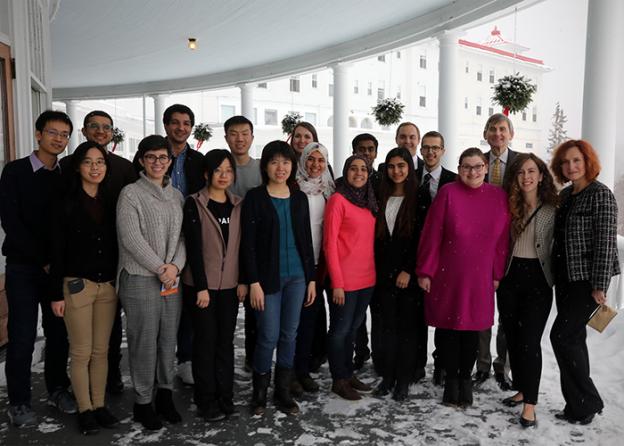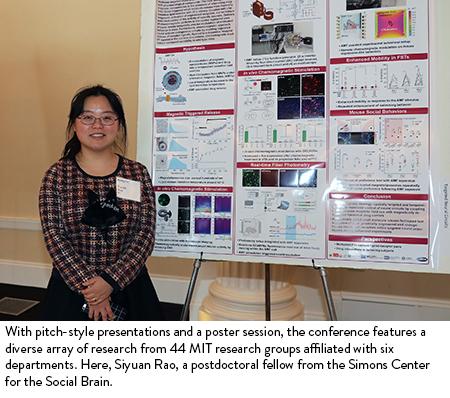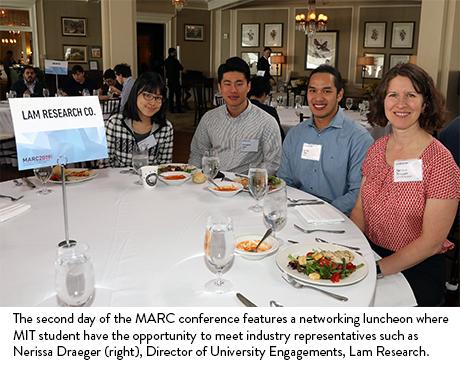
Held each January, the Microsystems Annual Research Conference (MARC), brings together MIT
faculty and students with industry partners to highlight cutting-edge research in microsystems, nanotechnology and more. MARC is led and organized by a student committee (pictured here), with support from the staff of the Microsystems Technology Laboratories (MTL).
Featuring the work of 44 research groups affiliated with six departments, the 2019 Microsystems Annual Research Conference (MARC) brought faculty and students together with industry partners in a diverse showcase for the latest MIT research in research in microsystems, nanotechnology and more.
Presented January 29-30 at the Omni Mount Washington Resort in Bretton Woods, New Hampshire, the two-day event included more than 100 pitch-style presentations, keynote speeches from industry leaders, a networking luncheon, and two poster sessions spanning 10 technical areas.
MARC is led and organized by a student committee, with support from the staff of the Microsystems Technology Laboratories (MTL). This year’s conference co-chairs were Sırma Örgüç and Alex Hanson, PhD candidates in electrical engineering and computer science (EECS).
“MARC is a unique event bringing the entirety of MTL together: students, industry, faculty, and staff. Each year is new and fresh as attendees present their research, connect MIT with industry, and enjoy social activities in- and outdoors,” says Örgüç, part of the Energy-Efficient Circuits and Systems group, led by professor and Dean of the School of Engineering Anantha Chandrakasan. “Students really look forward to its academic, career, and social value. MARC makes MTL a community.”
The two keynote speakers were Sophie Vandebroek, Vice President of Emerging Technology Partnerships at IBM Corporation, and Nevada Sanchez, co-founder of Butterfly Network, a manufacturer of a handheld ultrasound device that connects to a smartphone. They were joined at MARC by other industry representatives drawn from the 13 companies in the Microsystems Industrial Group (MIG), the MTL corporate consortium.

“The industry presence at MARC is really indispensable. Every year I see students and industry engineers sparking new ideas, suggesting collaborations, and arranging for internships and jobs,” says Hanson, the PhD co-chair and a member of the Power Electronics Research Group led by professor David Perrault in EECS. “Students get a view into the amazing work at MIG companies through the MIG pitches as well as targeted interactions at mealtime. It adds a reality to MARC, with insights into real-world constraints as well as real-world interest in students’ research.”
MARC is part of a week-long series of events at MTL called MTL EXPO that also includes the annual meeting of the Industrial Advisory Board (IAB) and StartUP@MTL, an event showcasing recent startups that have roots in MTL.
“MARC is a great opportunity to stay abreast of MIT’s leading-edge research and connect with its world-class students, so I look forward to attending every year,” said Nerissa Draeger, Director of University Engagements, Lam Research. “MTL, and now MIT.nano, are centers of excellence for some of the most advanced research in nanoscale processes and devices which is relevant to Lam Research and our customers. The student pitches and poster sessions provide an opportunity to learn more about this advanced research and how it might impact industry.”

“Over the years, the MTL charter broadened many times over to accommodate the explosive interest in nanotechnology in an ever-widening range of materials and devices for a multiplicity of applications,” says del Alamo, who is also Donner Professor in the Department of Electrical Engineering and Computer Science (EECS). “The program of MARC2019 reflects the extraordinary intellectual research that the services and facilities of MTL support.”
MTL recently passed administrative responsibility for its shared fabrication and other tools/instruments to MIT.nano, the new 200,000-square-foot nanoscale research center that launched at MIT in Fall 2018. Over the next several years, these toolsets will be transferred from their current locations in MTL to the new cleanrooms and other facilities of MIT.nano.
Next year, MTL and MIT.nano will co-sponsor MARC as part of a close and coordinated relationship to jointly support the faculty, students, and member companies associated with MTL.
RELATED LINKS:
MARC2019: https://www.mtl.mit.edu/mtlexpo/marc2019
Microsystems Technology Laboratories: https://www.mtl.mit.edu
Microsystems Industrial Group: https://www.mtl.mit.edu/microsystems-industrial-group
MIT.nano: https://mitnano.mit.edu